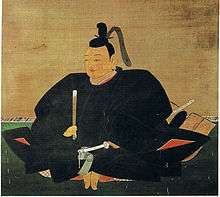Minamoto no Yoriie

Minamoto no Yoriie (源 頼家, September 11, 1182 – August 14, 1204) was the second shogun (1202–1203) of Japan's Kamakura shogunate, and the first son of first shogun Yoritomo.[1]
Life
Born to Tokimasa's daughter Hōjō Masako at Hiki Yoshikazu's residence in Kamakura, Yoriie had as wet nurses the wives of powerful men such as Hiki himself and Kajiwara Kagetoki, and also Hiki's younger sister.[2] Before he was born, his father Yoritomo had Hōjō Tokimasa and his men carry stones to build the Dankazura on Wakamiya Ōji to pray for the child's safe delivery.[2] When Yoriie later himself had an heir, Ichiman, the child was also born at the Hiki mansion[3] to Hiki's daughter Wakasa no Tsubone, a fact which further consolidated an already strong emotional bond.[4] From this relationship Hiki gained considerable influence when Yoriie became shogun, incurring the hostility of Hōjō Tokimasa, who was instead close to Yoriie's younger brother Senman (future third shogun Sanetomo), and who was in his turn trying to leverage that relationship for political advantage.
Yoriie showed when still very young great interest in military arts like fencing, and horse-riding. After his father's death in 1199, the 17-year-old became head of the Minamoto clan and was appointed seii taishogun in 1202.[2] He was, however, criticized for his abandonment of his father's policies, and his mother forbade him from any involvement political activity.[2] On June 30, 1203 (Shōji 1, 12th day of the 4th month) his remaining powers were formally taken from him and assumed by a council of 13 elders, headed by his grandfather Hōjō Tokimasa.[2] Yoriie in turn plotted with the Hiki to subjugate the Hōjō clan; however, he failed, was put under house arrest and forced to abdicate, and was eventually assassinated on July 17, 1204 in Izu.[2] Yoriie was succeeded by his younger brother Sanetomo, the last of the Seiwa Genji line to rule, at least nominally, over Kamakura.
Hiki Yoshikazu's rebellion
Seriously ill, Yoriie proposed to name both his younger brother Sanetomo, and his young son (Hiki's grandson) Minamoto no Ichiman to succeed him; the two would split power, governing separate parts of the country. It seemed natural to them that Hiki would then be the regent, even if unofficially, of young Ichiman. Hiki suggested to Yoriie, who would be assassinated shortly afterwards by a separate faction (the Hōjō clan), that they arrange to have Sanetomo killed. Hōjō Masako, Yoriie's mother and wife of the first shogun Yoritomo, allegedly overheard the conversation.
On a pretext, Hōjō Tokimasa invited Hiki Yoshikazu to his home and assassinated him. A battle between the clans ensued, the Hiki were defeated by a coalition of the Hōjō, Wada, Miura and Hatakeyama clans and were exterminated.
Yoriie died in Shuzenji, a small town in what was later called Izu province, assassinated by his uncle Hōjō Tokimasa.
Three sons of Yoriie
Yoriie had three sons, Ichiman, Kugyō,Senju-maru and he also had one daughter,Minamoto no Yoshiko married to fourth shogun of Kamakura,Kujo Yoritsune later she died when giving birth to Kujo Yoritsugu. But all of his son died of a violent death, victims of the power struggle that followed Yoritomo's sudden death. Ichiman (1198–1203) was the eldest. His mother Wakasa no Tsubone was Hiki Yoshikazu's daughter, and the child was brought up by the Hiki clan. There are contrasting versions of his death, but in any case he died in the fire that destroyed the Hiki residence. Second son Yoshinari, the only one of the three to reach adulthood, was forced to become a Buddhist monk (bonze) and in 1219 murdered his uncle Sanetomo on the stone stairs at Tsurugaoka Hachiman-gū in the shogunal capital of Kamakura, an act for which he was himself slain on the same day.[5]
Third son Senju-maru (千寿丸, 1201–1214) was 12 when Izumi Chikahira rebelled against the Hōjō to make the child shogun. After Chikahira's defeat, the child was forced to become a Buddhist monk like his older brother Yoshinari. A year later Wada Yoshimori also rebelled but, like Chikahira, was defeated and Senju-maru died with the others of the Wada clan.
Eras of Yoriie's bakufu
The years in which Yoriie was shogun are all within only one era name or nengō: Kennin (1201–1204).
Notes

- ↑ Nussbaum, Louis-Frédéric. (2005). "Minamoto no Yoriie" in Japan Encyclopedia, p. 635, p. 635, at Google Books.
- 1 2 3 4 5 6 Yasuda (1990:592-593)
- ↑ The mansion no longer exists and its location (35°19′1.31″N 139°33′20.95″E / 35.3170306°N 139.5558194°E) is occupied by Myōhon-ji a temple dedicated to the memory of the Hiki clan, exterminated by the Hōjō clan.
- ↑ Kamiya Vol. 1 (2008:44-45)
- ↑ Kusumoto (2002: 70-73)
References
- Kamiya, Michinori (2008). Fukaku Aruku - Kamakura Shiseki Sansaku Vol. 1 & 2 (in Japanese). Kamakura: Kamakura Shunshūsha. ISBN 4-7740-0340-9. OCLC 169992721.
- Kusumoto, Katsuji (July 2002). Kamakura Naruhodo Jiten (in Japanese). Tokyo: Jitsugyō no Nihonsha. ISBN 978-4-408-00779-3.
- Nussbaum, Louis-Frédéric and Käthe Roth. (2005). Japan encyclopedia. Cambridge: Harvard University Press. ISBN 978-0-674-01753-5; OCLC 58053128
- Papinot, Edmund. (1906) Dictionnaire d'histoire et de géographie du japon. Tokyo: Librarie Sansaisha...Click link for digitized 1906 Nobiliaire du japon (2003)
- Titsingh, Isaac. (1834). Nihon Odai Ichiran; ou, Annales des empereurs du Japon. Paris: Royal Asiatic Society, Oriental Translation Fund of Great Britain and Ireland. OCLC 5850691.
- Yasuda, Motohisa (editor) (1990). Kamakura, Muromachi Jinmei Jiten (in Japanese). Tokyo: Shin Jinbutsu Ōraisha. ISBN 978-4-404-01757-4. OCLC 24654085.
External links
- Ōmachi, by the Kamakura Citizen's Net, accessed on September 30, 2008
| Preceded by Minamoto no Yoritomo |
Kamakura Shogun: Minamoto no Yoriie 1202–1203 |
Succeeded by Minamoto no Sanetomo |